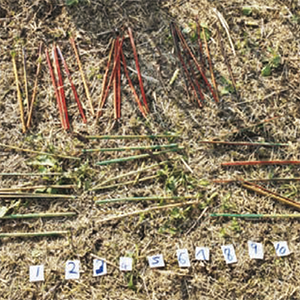Biomimetic tool design improves tillage efficiency, seedbed quality, and straw incorporation during rototilling in conservation farming

Published: 16 March 2023
Abstract Views: 958
PDF: 458
HTML: 66
HTML: 66
Publisher's note
All claims expressed in this article are solely those of the authors and do not necessarily represent those of their affiliated organizations, or those of the publisher, the editors and the reviewers. Any product that may be evaluated in this article or claim that may be made by its manufacturer is not guaranteed or endorsed by the publisher.
All claims expressed in this article are solely those of the authors and do not necessarily represent those of their affiliated organizations, or those of the publisher, the editors and the reviewers. Any product that may be evaluated in this article or claim that may be made by its manufacturer is not guaranteed or endorsed by the publisher.
Similar Articles
- Dario Friso, Marco Bietresato, ASSESSMENT OF DYNAMIC FEATURES OF MECHANICAL OSCILLATORS FOR A ROOT-BALLING MACHINE WITH A VIBRATING BLADE , Journal of Agricultural Engineering: Vol. 40 No. 4 (2009)
- Remo Alessio Malagnino, Performance analysis of photovoltaic plants installed in dairy cattle farms , Journal of Agricultural Engineering: Vol. 46 No. 2 (2015)
- Alessia Tonon, Lorenzo Picco, Diego Ravazzolo, Mario Aristide Lenzi, Using a terrestrial laser scanner to detect wood characteristics in gravel-bed rivers , Journal of Agricultural Engineering: Vol. 45 No. 4 (2014)
- Chiara Cevoli, Angelo Fabbri, Simone Virginio Marai, Enrico Ferrari, Adriano Guarnieri, Estimation of thermal conductivity of short pastry biscuit at different baking stages , Journal of Agricultural Engineering: Vol. 45 No. 2 (2014)
- G. Sperandio, M. Fedrizzi, M. Iacurto, F. Vincenti, M. Guerrieri, D. Pochi, R. Fanigliulo, M. Pagano, Enhancement of Palm residues (Phoenix canariensis) for a potential use in ruminant feed , Journal of Agricultural Engineering: Vol. 44 No. s2 (2013): Proceedings of the 10th Conference of the Italian Society of Agricultural Engineering
- Andrea Rosario Proto, Alois Skoupy, Giorgio Macri, Giuseppe Zimbalatti, Time consumption and productivity of a medium size mobile tower yarder in downhill and uphill configurations: a case study in Czech Republic , Journal of Agricultural Engineering: Vol. 47 No. 4 (2016)
- Pietro Picuno, Vernacular farm buildings in landscape planning: a typological analysis in a southern Italian region , Journal of Agricultural Engineering: Vol. 43 No. 3 (2012)
- Andrea De Montis, Simone Caschili, Amedeo Ganciu, Antonio Ledda, Filippo Paoli, Federico Puddu, Mario Barra, Strategic environmental assessment implementation of transport and mobility plans. The case of Italian regions and provinces , Journal of Agricultural Engineering: Vol. 47 No. 2 (2016)
- Ildar Gabitov, Samat Insafuddinov, Denis Kharisov, Elmir Gaysin, Timur Farhutdinov, Diagnostic method and device for evaluating and forecasting the technical condition of farm machinery in operation , Journal of Agricultural Engineering: Vol. 52 No. 4 (2021)
- Fabiana Convertino, Ileana Blanco, Evelia Schettini, Giuliano Vox, A nature-based system for improving Mediterranean buildings’ performance: contribution to energy saving by heat transfer reduction and influence of climatic parameters , Journal of Agricultural Engineering: Vol. 54 No. 3 (2023)
<< < 13 14 15 16 17 18 19 20 21 22 > >>
You may also start an advanced similarity search for this article.

 https://doi.org/10.4081/jae.2023.1327
https://doi.org/10.4081/jae.2023.1327







